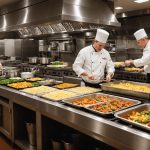Elevate your buffet restaurant experience by incorporating a live cooking station. This innovative approach not only captivates guests but also enhances their dining experience through the sights, sounds, and aromas of freshly prepared dishes. With the right strategies, you can transform your offerings and create a vibrant atmosphere that keeps diners coming back for more. Discover essential tips that will help you design an engaging live cooking station, ensuring your buffet stands out in a competitive market. Get ready to ignite excitement at your tables.
Understanding the Benefits of a Live Cooking Station
Exploring the advantages of interactive dining experiences.
This might interest you : Essential Emergency Response Training for Bar Staff: Equip Your Team to Handle Crisis Situations Effectively
Increased Customer Engagement and Satisfaction
Live cooking stations significantly boost customer engagement by allowing diners to interact directly with chefs. This interaction creates a personalized experience, as guests can customize their meals and witness their preparation. Watching a chef at work can be both entertaining and educational, enhancing the overall dining experience.
Enhanced Dining Experience with Fresh, Made-to-Order Meals
The appeal of fresh, made-to-order meals is undeniable. Live cooking stations ensure that dishes are prepared on the spot, which guarantees freshness and quality. This immediacy not only enhances flavor but also assures customers of the hygiene and ingredients used, leading to higher satisfaction.
This might interest you : Essential Legal Guidelines for Waste Disposal in London Restaurants: A Comprehensive Overview
Potential for Higher Sales and Repeat Customers
The unique experience provided by live cooking stations often translates into increased sales. Customers are more likely to return for the distinctive dining experience, thus fostering customer loyalty. Additionally, the novelty and engagement factor can encourage diners to spend more, positively impacting revenue.
Benefits of Live Cooking Stations:
- Interactive and engaging dining
- Fresh, customizable meals
- Increased customer loyalty and sales
By incorporating a live cooking station, restaurants can create an engaging atmosphere that not only captivates but also retains customers, ensuring a memorable dining experience.
Equipment Needed for a Live Cooking Station
Creating an efficient and engaging culinary setup.
Essential Cooking Equipment
Setting up a live cooking station requires careful selection of cooking station equipment. Key appliances include grills, fryers, and induction cooktops. These tools are vital for preparing a variety of dishes quickly and efficiently. The choice of equipment should align with the menu offerings to ensure versatility and speed.
Importance of Safety and Hygiene
When selecting kitchen appliances for a live cooking station, prioritizing safety and hygiene is crucial. Equipment should comply with health standards to maintain cleanliness. Features like non-slip surfaces and easy-to-clean materials can prevent accidents and ensure a safe cooking environment. This not only protects staff but also reassures customers of the station's cleanliness.
Space Considerations
The layout of the buffet setup is essential for optimal workflow. Adequate space must be allocated for each piece of cooking station equipment to avoid congestion. A well-organized space allows chefs to move freely, enhancing efficiency and reducing wait times for diners. Consider the flow of guests and staff to optimize the overall dining experience.
Key Equipment for Live Cooking Stations:
- Grills
- Fryers
- Induction cooktops
By carefully selecting and arranging kitchen appliances, restaurants can create a live cooking station that is both functional and appealing, ensuring a seamless operation.
Selecting Ingredients for Your Live Cooking Station
Crafting a menu with fresh, high-quality ingredients.
Importance of Fresh, High-Quality Ingredients
Choosing fresh ingredients is crucial for any live cooking station. The vibrancy and taste of dishes largely depend on the quality of the ingredients used. Freshness not only enhances flavor but also ensures nutritional value, providing diners with a wholesome experience. High-quality ingredients contribute to the authenticity and appeal of the dishes, making them more enticing to customers.
Sourcing Local and Seasonal Produce
Opting for local and seasonal produce can elevate your menu. Not only does this practice support local farmers, but it also guarantees the freshness of ingredients. Seasonal produce is often more flavorful and cost-effective, allowing for creative and sustainable menu planning. By sourcing locally, you can offer dishes that reflect the region's culinary heritage, adding a unique touch to your live cooking station.
Menu Ideas That Work Well for Live Cooking
Designing a menu that complements the live cooking concept involves selecting dishes that highlight the freshness of ingredients. Consider options like stir-fries, pasta stations, or omelet bars that can be quickly prepared and customized.
Key Menu Ideas:
- Stir-fries with seasonal vegetables
- Made-to-order pasta
- Customizable omelet bars
By focusing on fresh, high-quality ingredients, your live cooking station can deliver an exceptional dining experience that resonates with customers.
Creative Presentation Techniques
Enhancing the dining experience through visual appeal.
Importance of Visual Appeal in a Buffet Setting
In a buffet setting, the visual appeal of food can significantly influence a diner's choice and satisfaction. Food presentation is not just about aesthetics; it's an essential part of the overall dining experience. Well-plated dishes can entice customers and set the tone for their meal. By focusing on plating techniques, restaurants can create a memorable impression that encourages diners to return.
Techniques for Plating That Enhance Customer Experience
Effective plating techniques can transform a dish from ordinary to extraordinary. Chefs can use contrasting colors and textures to create visual interest. Arranging food in layers or using geometric shapes can add sophistication. The use of negative space ensures that each element stands out, enhancing the visual appeal and making the dish more inviting.
Use of Garnishes and Accompaniments for Added Flair
Garnishes and accompaniments can elevate a dish's visual appeal and add flavor. Fresh herbs, edible flowers, or colorful sauces can be strategically placed to enhance the food presentation. These elements not only add a pop of color but also provide a sensory experience, making each dish more enticing.
Key Plating Elements:
- Contrast in colors
- Strategic use of negative space
- Fresh and edible garnishes
Staffing Considerations for Your Cooking Station
Ensuring a seamless and engaging dining experience.
Ideal Staffing Levels for Efficiency and Service
Determining the ideal staffing levels for a live cooking station is crucial for maintaining efficiency and service quality. A well-staffed station ensures that meals are prepared promptly, minimizing wait times and enhancing customer satisfaction. Typically, each station should have a chef and at least one assistant to manage peak hours efficiently. This setup allows for smooth operations and quick service.
Training Staff to Engage with Customers Effectively
Staff training is essential for fostering positive customer interactions. Employees should be equipped with communication skills to engage diners, answer questions, and provide recommendations. Training should also focus on maintaining composure during busy periods while ensuring that each customer feels valued. This approach not only enhances the dining experience but also builds customer loyalty.
Role of Chefs in Creating an Interactive Atmosphere
The role of chefs extends beyond cooking; they are pivotal in creating an interactive atmosphere. Chefs should be personable, engaging diners with their culinary expertise and showmanship. This interaction can involve explaining dishes, offering tasting samples, or customizing meals according to preferences. Such interactions make the dining experience memorable and encourage repeat visits.
Key Staffing Considerations:
- Optimal staffing levels
- Comprehensive staff training
- Engaging chef interactions
By focusing on these elements, restaurants can ensure their cooking stations operate smoothly and provide an exceptional dining experience.
Customer Interaction Methods
Enhancing the guest experience through interactive dining.
Strategies for Encouraging Customer Participation
Creating an inviting atmosphere around a cooking station is crucial for boosting customer engagement. To achieve this, consider implementing strategies that encourage diners to participate in the culinary process. For instance, offering tasting samples or inviting guests to select ingredients for their dishes can make the experience more interactive. This not only enhances the guest experience but also fosters a sense of inclusion and excitement.
Importance of Communication Between Chefs and Guests
Effective communication between chefs and guests is vital for a successful interactive dining experience. Chefs should be approachable and ready to engage with diners, answering questions and offering insights into the cooking process. This dialogue not only enriches the guest experience but also builds a personal connection, making the meal more memorable. Encouraging chefs to share stories about the dishes can further captivate diners.
Creating an Inviting Atmosphere
An inviting atmosphere around the cooking station is essential for facilitating customer engagement. Consider the layout and design of the station to ensure it is welcoming and accessible. Ambient lighting, pleasant aromas, and a visually appealing setup can draw diners in and make them feel at ease.
Key Elements for Interaction:
- Tasting samples
- Ingredient selection
- Chef storytelling
By focusing on these elements, restaurants can significantly enhance the interactive dining experience.
Success Stories: Examples of Effective Live Cooking Stations
Exploring real-world implementations and their impact.
Overview of Successful Restaurant Setups
Many restaurants have embraced live cooking stations to enhance their dining experiences. For instance, a renowned hotel in Singapore successfully integrated a live cooking station into their buffet. This setup allowed guests to witness chefs preparing fresh seafood dishes, boosting customer engagement and satisfaction.
Key Elements Contributing to Success
Several factors contribute to the success of these case studies. A well-thought-out layout ensures smooth operations and an inviting atmosphere. Additionally, the use of high-quality ingredients and skilled chefs enhances the appeal. Effective communication between chefs and guests is crucial, as it encourages interaction and creates a memorable dining experience.
- Interactive chef performances
- High-quality, fresh ingredients
- Efficient layout and design
Lessons Learned from Successful Implementations
These successful setups offer valuable insights. Prioritizing customer engagement through interactive elements can significantly enhance the dining experience. Investing in skilled staff and quality ingredients is essential for maintaining high standards. Restaurants should also consider feedback from diners to continuously improve their live cooking stations.
By learning from these restaurant examples, establishments can implement live cooking stations that not only attract but retain customers, ensuring a unique and enjoyable dining experience.
Marketing Your Live Cooking Station
Enhancing visibility through strategic approaches.
Effective Promotional Strategies
To effectively market your live cooking station, consider implementing promotional strategies that highlight its unique appeal. Showcase the interactive and engaging aspects through captivating visuals and storytelling. Host exclusive events or themed nights that revolve around your live cooking concept to attract customers. Offering discounts or loyalty programs can also entice diners to experience the unique offerings of your station.
Utilizing Social Media
Social media is a powerful tool for restaurant marketing. Use platforms like Instagram and Facebook to showcase the live cooking experience through videos and photos. Highlight customer interactions and the freshness of your dishes. Encourage diners to share their experiences online by creating a unique hashtag. This not only increases visibility but also builds a community around your restaurant.
Collaborating with Local Events or Influencers
Collaborations with local events or influencers can significantly amplify your promotional strategies. Partner with food festivals or local markets to feature your live cooking station. Influencers can share their experiences, attracting their followers to your restaurant. This approach not only enhances your reach but also adds credibility to your offerings.
Key Marketing Strategies:
- Exclusive events and themed nights
- Social media campaigns with unique hashtags
- Collaborations with local influencers and events
By focusing on these strategies, your live cooking station can become a standout feature in your restaurant marketing efforts.
Challenges and Solutions in Implementing a Live Cooking Station
Navigating operational hurdles for a seamless dining experience.
Common Challenges Faced
Implementing a live cooking station presents several operational challenges. Restaurants often struggle with maintaining efficiency during peak hours, which can lead to longer wait times and decreased customer satisfaction. Additionally, ensuring consistent quality while managing a high volume of orders can be daunting. The need for skilled staff to handle both cooking and customer interactions adds to the complexity.
Solutions for Efficiency and Satisfaction
To overcome these challenges, restaurants can adopt several strategies. Flexibility in operations is crucial; adjusting staff levels and roles during busy periods can help maintain efficiency. Implementing streamlined processes and prep work before service begins can reduce cooking times. Training staff to multitask and engage with customers effectively can enhance the overall experience.
Importance of Flexibility in Operations
Flexibility is key to addressing operational challenges. Being able to swiftly adapt to changing circumstances, such as unexpected rushes or equipment malfunctions, ensures that customer satisfaction remains high. Regularly reviewing and optimizing workflows can further improve efficiency.
Key Strategies:
- Flexible staffing
- Streamlined processes
- Regular workflow reviews
By focusing on these solutions, restaurants can successfully navigate the complexities of running a live cooking station, ensuring a smooth and enjoyable experience for diners.
Measuring Success and ROI of Your Live Cooking Station
Evaluating the impact and effectiveness of your culinary setup.
Key Performance Indicators to Evaluate Success
To determine the success of your live cooking station, start by identifying key performance indicators (KPIs). These might include customer satisfaction scores, the number of repeat visits, and sales growth attributed to the station. Monitoring these metrics can provide insights into the station's effectiveness and areas for improvement.
Gathering and Analyzing Customer Feedback
Customer feedback is crucial for assessing the performance of your live cooking station. Implement surveys or feedback forms to capture diners' thoughts on the interactive experience and food quality. Analyzing this data helps identify strengths and weaknesses, guiding future enhancements. Consider using a simple table to track feedback trends:
| Feedback Aspect | Positive (%) | Negative (%) |
|---|---|---|
| Food Quality | 85% | 15% |
| Customer Engagement | 90% | 10% |
| Service Speed | 80% | 20% |
Financial Considerations and Return on Investment Analysis
Evaluating the financial performance of your live cooking station is essential. Calculate the return on investment (ROI) by comparing the station's revenue against its operating costs. Consider factors such as increased customer loyalty and reduced food waste, which can positively impact ROI. Regular financial analysis ensures that the station remains a profitable and sustainable venture.











